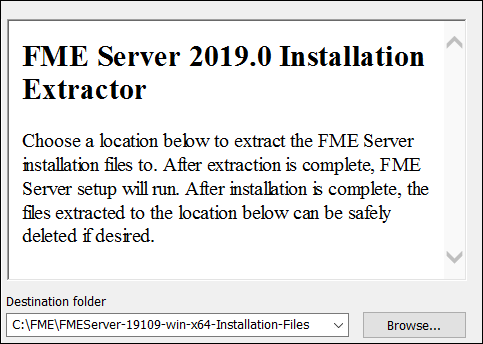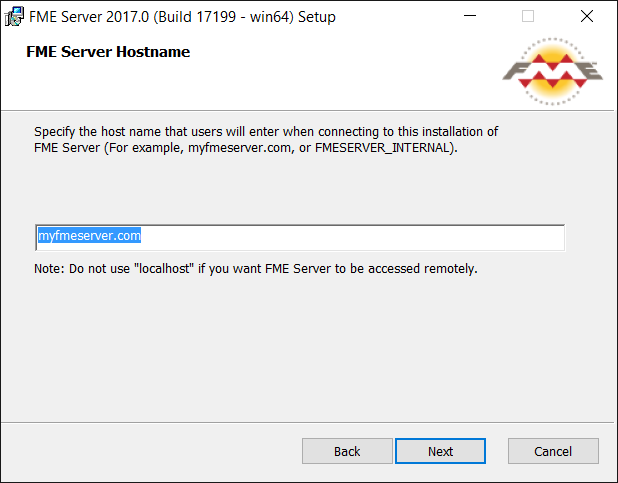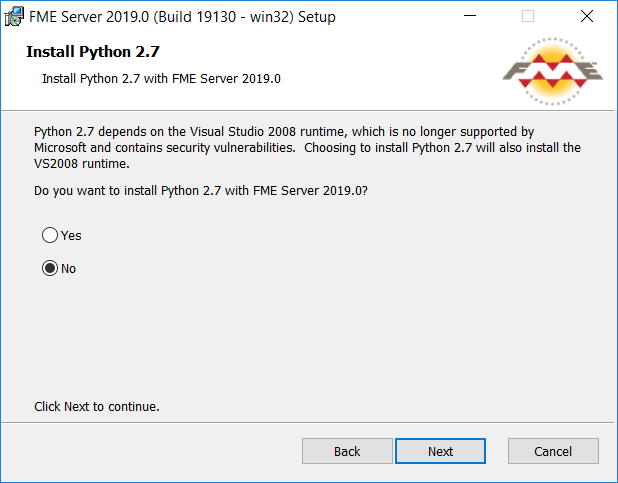Run the installer under an administrator account. This account must have:
- Write privileges to the specified installation directory.
- "Log on as a service" rights on this machine. For more information, see this Microsoft Docs article.
FME Server Installation Extractor
Start the FME Server installer.
On the Installation Extractor dialog, specify a Destination folder in which to extract installation files. Note that this folder only specifies where installation files are extracted—it does not specify where FME Server program files are installed. That location is specified later in the installer.
Tip: Take note of the specified Destination folder location. Following installation, you may wish to:
 Review the installation .log file.
Review the installation .log file.
 Remove these files. Doing so saves almost 2 GB disk space.
Remove these files. Doing so saves almost 2 GB disk space.

Click Install.
When extraction is complete, the installer opens. Proceed through the installer to the Choose Setup Type dialog.
Choose Setup Type
Select the Express option.

Destination Folder
- Install FME Server to: By default, most files for your FME Server installation are written to C:\Program Files\FME Server\. To change the installation directory, modify the path.
- Install the FME Server System Share to: By default, FME Server System Share files, which include Repositories and Resources, are written to %ALLUSERSPROFILE% \Safe Software\FME Server\.
- Install the FME Server Database files to: By default, FME Server Database files are written to %ALLUSERSPROFILE%\Safe Software\FME Server\pgsql\data.
Note: Unless modified, C:\ProgramData is the default value of the %ALLUSERSPROFILE% environment variable.
This configuration is recommended, because applications that use FME Server to write data can access C:\ProgramData\Safe Software\FME Server when all FME Server System Services run under the local system account (the most common scenario), while the remaining files are protected in a read-only location. To change the installation directory of FME Server System Share files, modify the path.
Note: If you plan to scale-out your FME Server anytime following installation by Adding FME Engines on a Separate Machine, the specified directory must be read/write accessible by the account that runs the additional FME Engines.
Note: Unless modified, C:\ProgramData is the default value of the %ALLUSERSPROFILE% environment variable.
To change the installation directory of FME Server Database files, modify the path.

FME Server Hostname
If this FME Server installation will be available to users outside an internal network (for example, on an external website), specify the external hostname that users will enter when connecting to FME Server. For example, if you are hosting FME Server on myfmeserver.com/myfmeserver, enter myfmeserver.com.
Otherwise, enter the internal server hostname, IP Address, or DNS.

Web Application Server Port
Port 80 is the recommended default. If this port is in use, port 8080 is recommended.
Note: Common applications that may be using port 80 include Skype and Internet Information Services (IIS). Either turn off these services, or select a different port, such as 8080.

Install Python 2.7
This dialog asks if you want to include an optional Python 2.7 interpreter with the installation. (A Python 3.7 interpreter is installed by default.)
WARNING: The Python 2.7 interpreter relies on the Visual Studio 2008 runtime, which has security vulnerabilities. If you will run existing FME Desktop workspaces from FME Server that reference Python 2.7, we strongly recommend upgrading them to reference Python 3.x in lieu of installing the Python 2.7 interpreter.

On the last screen, click Install.
Proceed to Starting and Stopping FME Server.